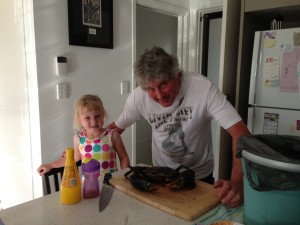Sorenne and I dismembered a muddy for dinner the other day (after humanely anesthetizing it in the freezer for an hour) before cooking and devouring muddy along with some bay bugs.
Daughter Courtlynn and I have been e-mailing about the virtues of Australian  crabs versus the sweetness of the stone crabs we had in Florida.
crabs versus the sweetness of the stone crabs we had in Florida.
Not bad for a couple of landlubbers.
But whatever your nautical preference, cook it safe.
The following abstract was published in the current Journal of Food Science, focusing on safe shrimp and salmon preparation. The problem is, how is an extra jumbo shrimp defined? Maybe it’s in the paper, but why not just use a tip-sensitive digital thermometer to account for subjective variations?
Stick it in. I do
Optimum cooking conditions for shrimp and atlantic salmon
Journal of Food Science
Lauren Brookmire, P. Mallikarjunan, M. Jahncke, R. Grisso
The quality and safety of a cooked food product depends on many variables, including the cooking method and time–temperature combinations employed. The overall heating profile of the food can be useful in predicting the quality changes and microbial inactivation occurring during cooking. Mathematical  modeling can be used to attain the complex heating profile of a food product during cooking. Studies were performed to monitor the product heating profile during the baking and boiling of shrimp and the baking and pan-frying of salmon. Product color, texture, moisture content, mass loss, and pressed juice were evaluated during the cooking processes as the products reached the internal temperature recommended by the FDA. Studies were also performed on the inactivation of Salmonella cocktails in shrimp and salmon. To effectively predict inactivation during cooking, the Bigelow, Fermi distribution, and Weibull distribution models were applied to the Salmonella thermal inactivation data. Minimum cooking temperatures necessary to destroy Salmonella in shrimp and salmon were determined. The heating profiles of the 2 products were modeled using the finite difference method. Temperature data directly from the modeled heating profiles were then used in the kinetic modeling of quality change and Salmonella inactivation during cooking. The optimum cooking times for a 3-log reduction of Salmonella and maintaining 95% of quality attributes are 100, 233, 159, 378, 1132, and 399 s for boiling extra jumbo shrimp, baking extra jumbo shrimp, boiling colossal shrimp, baking colossal shrimp, baking Atlantic salmon, and pan frying Atlantic Salmon, respectively.
modeling can be used to attain the complex heating profile of a food product during cooking. Studies were performed to monitor the product heating profile during the baking and boiling of shrimp and the baking and pan-frying of salmon. Product color, texture, moisture content, mass loss, and pressed juice were evaluated during the cooking processes as the products reached the internal temperature recommended by the FDA. Studies were also performed on the inactivation of Salmonella cocktails in shrimp and salmon. To effectively predict inactivation during cooking, the Bigelow, Fermi distribution, and Weibull distribution models were applied to the Salmonella thermal inactivation data. Minimum cooking temperatures necessary to destroy Salmonella in shrimp and salmon were determined. The heating profiles of the 2 products were modeled using the finite difference method. Temperature data directly from the modeled heating profiles were then used in the kinetic modeling of quality change and Salmonella inactivation during cooking. The optimum cooking times for a 3-log reduction of Salmonella and maintaining 95% of quality attributes are 100, 233, 159, 378, 1132, and 399 s for boiling extra jumbo shrimp, baking extra jumbo shrimp, boiling colossal shrimp, baking colossal shrimp, baking Atlantic salmon, and pan frying Atlantic Salmon, respectively.
